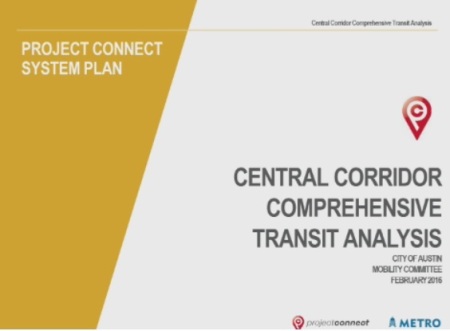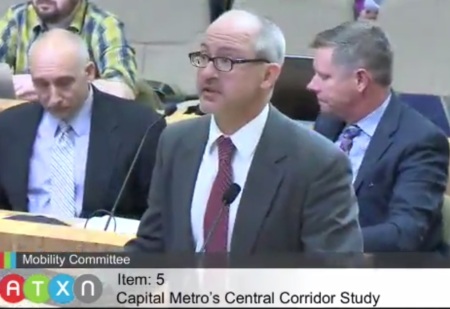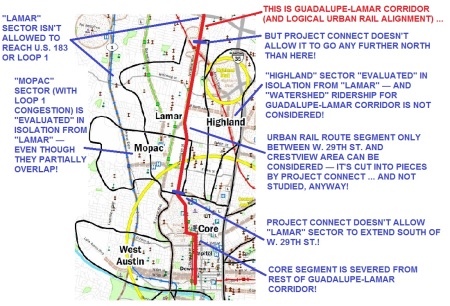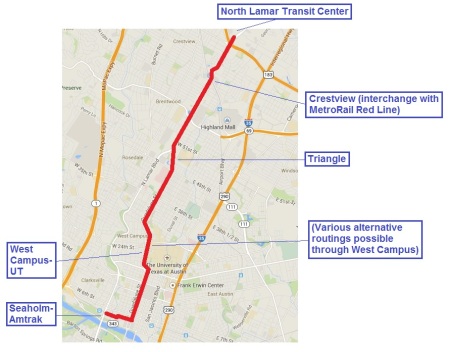
Title slide of Capital Metro’s CCCTA presentation to Austin City Council Mobility Committee on Feb. 3rd. Screen capture: ARN.
♦
After months of preparation, organizing, bidding, and selection, with lots of fanfare Capital Metro at last launched its $3 million, 30-month (2.5-years) Central Corridor Comprehensive Transit Analysis (CCCTA) study. In a Jan. 25th news release, Capital Metro announced that its board of directors had selected engineering firm AECOM as the lead consultant to conduct the Central Corridor analysis.
To the uninitiated, inexperienced, and uninformed, this latest study might seem some kind of step forward for Austin’s transit development. After all, its elements include impressive-sounding goals like “An in-depth study of a variety of transportation modes and their potential for creating improved transit options within the corridor”, “A multimodal transportation plan that improves the feasibility of transit in the Central Corridor while effectively maximizing connections with regional routes in surrounding communities”, and “A realistic cost analysis for building, operating and maintaining the proposed sustainable and connected transit system”.

Capital Metro’s planning chief Todd Hemingson explains CCCTA study to Austin City Council Mobility Committee on Feb. 3rd. Photo: ARN screenshot from official video.
Analysis Paralysis gold medal
But, among grassroots public transportation advocates in Austin, it’s hard to find a transit supporter who’s enthusiastic about this study. The reason: All of these issues have already been exhaustively studied, and plans prepared and re-prepared, over and over and over and over again, for more than two decades. For Austin transit supporters, we’ve “been there, done that” — multiple times. It’s just one more repetitive “re-study of the re-studies of the re-studies ….”
To get a breathtaking idea of the time, resources, energy, and money Austin has sunk into planning for “high-capacity” public transport, just check out our February 2015 chronicle of studies and re-studies of light rail transit (LRT) in the Guadalupe-Lamar corridor: «Long saga of Guadalupe-Lamar light rail planning told in maps». This central travel corridor’s high level of traffic, population and employment density, and crucial position accessing and connecting vital activity centers (like UT, the Capitol Complex, and downtown) with key established neighborhoods and extended commercial activity along the route have made it the focus of planning for rail transit for over three decades.
In terms of public transit, Austin clearly is a top contender for the Analysis Paralysis gold medal. And Capital Metro’s latest CCCTA study, as it’s currently designed, surely represents Exhibit A toward this dubious award. The confusion, misdirection, conflicting intentions, and lack of purpose underlying this “paralysis” were discussed in our March 2015 article «Austin’s urban transport planning seems struck by catastrophic case of amnesia and confusion».
Meanwhile, as meaningful public transport planning continues to languish, the Austin metro area is experiencing a veritable blitz of intensive highway development and construction, including at least three new tollways, massive projects on I-35, and assorted projects throughout the urban area. As the saying goes, “Roads get built, transit gets studied“.
Project Connect back from the dead?
But confusion and a continuation of “analysis paralysis” aren’t the only problems with the CCCTA study. As currently configured, the study seems little more than a rehash of Project Connect’s ill-fated “High-Capacity Transit Study” which elicited such intense community outrage beginning in 2013, the precursor to its ultimate resounding rejection by voters in November 2014. Indeed, the CCCTA project seems the first major effort to resuscitate Project Connect since its 2014 debacle.
Among the worst weaknesses of the Project Connect disinterment is the revival of the seriously flawed methodology of the earlier “analysis”. This includes ignoring actual, existing travel corridors — such as the pre-eminent Guadalupe-Lamar corridor — and instead mislabeling huge chunks and sectors of the city as “corridors”. (The methodology further subdivided the “Central Corridor” into “subcorridor” mini-sectors.) Thus, according to Capital Metro, per the CCCTA study, “The Central Corridor is defined as an area bordered on the south by Ben White (US-290), on the east by the Capital Metro’s Red Line, on the north by RM 2222/Koenig Lane, and on the west by MoPac Expressway, and includes downtown Austin.”
Not only is that vast glob of central Austin not a corridor, but (as in the 2013 activity) this approach slices and truncates actual travel corridors, particularly Guadalupe-Lamar, rather than analyzing them in terms of their suitability and potential for actually solving mobility problems with public transport (particularly urban rail). We analyzed the problems with this in our November 2013 article «Project Connect’s “corridor” study — without corridors!»

Methodology of Project Connect study in 2013 labeled huge chunk of central city as a “corridor”, but severed actual intact travel corridors into meaningless pieces. Graphic: ARN. (Click to enlarge.)
Community skepticism about Capital Metro’s “corridor” methodology in the CCCTA study was illustrated as early as last September by Jace Deloney, a co-founder of the influential AURA group (involved with urban and transportation issues) and former chairman of the City’s Urban Transportation Commission and Capital Metro’s Customer Satisfaction Advisory Committee:
It’s very important that we advocate against using the previous subcorridor definitions for any future high capacity transit planning project. In my opinion, these subcorridor definitions were deliberately designed to end up with a Red River alignment recommendation.
Re-direct the CCCTA study!
Besides the exhaustive “saga” of studies of the Guadalupe-Lamar corridor detailed in the ARN article cited and linked above, Austin Rail Now and other community stakeholders have presented LRT alternative alignment and design proposals that provide more than enough basis for quickly reaching a decision for an urban rail starter line. The most recent proposals are described in several ARN articles:
• Plan for galvanizing Austin’s public transport development: Light rail starter line in Guadalupe-Lamar (June 2015)
• Another major Austin community recommendation for light rail transit in Guadalupe-Lamar (November 2015)
• Another possible design for light rail in Guadalupe-Lamar corridor (January 2016)
So far, in the absence of any sense of direction toward a major urban rail investment, Austin’s top political and civic leadership is vulnerable to pressure by highway interests (such as TxDOT) for municipal general obligation bond funding for a heavy local investment in a massive I-35 overhaul and other huge highway projects. To this, a major rail transit starter line investment might be counter-proposed as a far more effective and desirable alternative for city bond funding.
It would definitely seem time to end Austin’s decades of “analysis paralysis” and move forward quickly toward finalizing an urban rail plan for public approval — a strategy that could be expedited by re-directing Capital Metro’s CCCTA study. There is certainly sufficient planning and design preparatory work already in place to provide the voting public a basis on which to make a decision for the Guadalupe-Lamar corridor. The AECOM consultant team (widely respected in the public transportation industry, with experience with LRT in Portland, Minneapolis, and elsewhere) could simply update and tweak the major engineering studies that have already been done (e.g., those in 1993 and 2000) for the Guadalupe-Lamar corridor.

Austin Rail Now proposal is one of several possible configurations already suggested for light rail starter line in Guadalupe-Lamar corridor. Graphic: ARN.
This would likely require a major intervention by Austin City Council members to request Capital Metro to negotiate with its consultant team for a modification of the CCCTA work plan — eliminating the proposed 30-month “slow track” study, and re-directing the project into planning, design, and engineering of LRT for the Guadalupe-Lamar corridor as suggested above. This would have the aim of placing a measure on the ballot for bond funding (to be kept in escrow till further planning and Preliminary Engineering/Environmental Impact Study tasks are completed). Adequate cost estimates are already on hand for such a ballot measure.
According to Surinder Marwah, the former Capital Metro Senior Planner who secured federal funding for the MetroRapid bus project, this can be “a reasonable plan if the elected officials, business leaders and major stakeholders can come to an agreement” for the general Guadalupe-Lamar alignment corridor. “AECOM can update the preliminary cost estimates quickly and perform fatal flaw analysis for the alignment corridor within few months — by mid-late August to get this into [a] November ballot measure.”
Capital Metro’s currently contrived CCCTA study seems little more than a “holding pattern” reflecting the indecisiveness and lack of will of key public officials in regard to public transport policy. Re-directing this study as proposed above would at long last move Austin’s rail public transport development into a widely supported action phase and head it expeditiously toward the mobility quantum leap Austinites have so long been denied. ■

